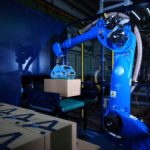Helmut Prieschenk, CEO of Witron Logistik + Informatik GmbH, explains how sustainability is changing in logistics, why this topic is facing a paradigm shift, and why ecology, economy, and social factors are not contradictory.
“This topic is also very present in North America, although in a different way,” says Prieschenk. “There are still big cars, but Americans are noticing the price increase for fuel and are seeing the impact of human behaviour. Consumers are demanding real action from retailers – not just green washing – and government programs are enticing with big money when it comes to energy-efficiency and sustainability. Even there, space for logistics property is becoming scarce. Brownfield projects are becoming increasingly important. The suppliers are well-established, the site is integrated into the logistics network, the transportation infrastructure and energy supply already exist, and the logistics employees are on site and no longer need to be recruited. True to the credo ‘use your assets’, we can offer very good support with our solutions here as well and have already proven in many projects throughout Europe that we can successfully integrate new technology into an existing building during ongoing operations. Regeneration is the buzzword in Canada and the United States right now.”
What does this mean for WITRON? Move away from repair logic, according to the German company. The problems should not be solved in the distribution centre, but where they arise. The idea: In addition to IE4 motors, energy recovery on the stacker cranes, or photovoltaic systems, it is about avoiding unnecessary movements in the logistics centre. “We have to re-define efficiency in the design phase with the customer. First, of course, it is about the distribution centre and the number of pallets and customer orders that are handled every day. Equally important are issues such as service levels for store and end customers as well as cost-efficiency. This is mandatory. In the future, however, we will have to think much further ahead. The highlight will then be to combine the performance data with the consumptions.” Therefore, WITRON employees analyze the performance and energy data during the design, realization, and operation phases. Prieschenk is convinced: “We have to question things like whether it would make sense to handle less inventory in the supply chain. Productivity is the buzzword.”
This aspect is obviously very important to retailers and store operators. ‘Stock-out’ is a crucial topic in this business sector. But in the future, we dare to run a logistics centre with less buffer and with more knowledge from data, to build even more efficient warehouses, to avoid food waste, to save energy – and we have to question business models that do not work economically, socially, and ecologically. Instead of ESG, it has to be “ESB” – Environmental, Social, and Business – only then will we succeed together with our customers.” The CEO is certain: “In the future, in addition to the performance data of machines and distribution centres, our press releases will of course contain information on CO2 emissions per colli or on the energy management of the system.”
Do we need the slip sheets?
This requires efforts by WITRON, the customer, and in the supply chain. “Our OnSite teams in the logistics centres know the system and the processes. If they notice, for example, that suppliers use unnecessary overpack, then we immediately seek discussions with them. In some cases, suppliers use slip sheets within the pallets, which aren’t really needed.” According to WITRON it is important to actively search for efficiency gains down to the last detail. It’s often time-consuming, but also very successful. “There is usually optimization potential just as much in the order behavior of the stores or the end consumers, in route scheduling, or in truck utilization.”
Energy demand
The logistics centre is like an electric car, the engineers at WITRON are convinced. The customer could permanently run the warehouse at maximum performance and challenge the machines, but does that really make sense in terms of the overall concept? “The electric motor in the car is extremely efficient – as are our systems. And we can quickly speed up processes when it becomes necessary. But just as you have to learn to drive an electric car, you have to learn how to run a logistics centre cost-efficiently and consumer-friendly, but still dimension and operate it ecologically. To do that, we need the customer, the data, and the supplier, as well as the stores and the consumers. “And,” adds Prieschenk, “we have to plan exactly, which route we are taking. For logistics, that means: where do the demands arise, how do we respond to them, what can we predict?”
At the same time, the requirements in the supply chains are rising. WITRON only produces in Germany – the new plant was built into the depth to save space, and the photovoltaic system on the roof supplies 2.5 megawatt. “We have to keep quality high and make sure our machines and systems are easy to clean. “That doesn’t sound like a unique selling point, but it is extremely important because our customers want to operate the system for 30 to 40 years. That’s when it really becomes sustainable.” Wouldn’t it be possible to produce more than 2.5 megawatt? Sure, we could, but we need to question ourselves if this is really needed? After all, the PV modules have to be produced. We need to finally look at the demand aspect of energy, not always just the offer.”
The post Sustainability: ‘Move away from repair logic’ appeared first on Logistics Business® Magazine.

